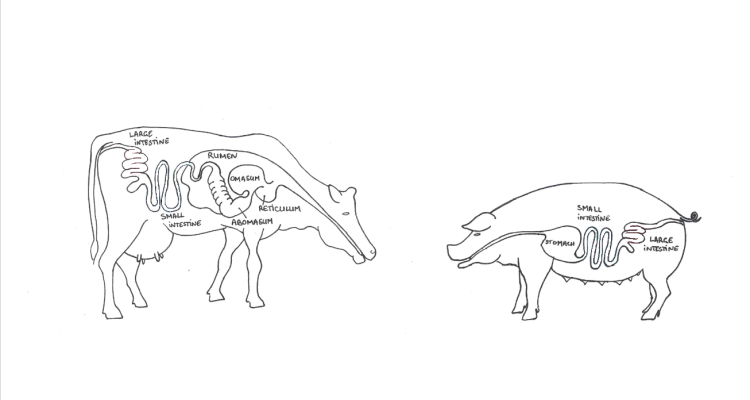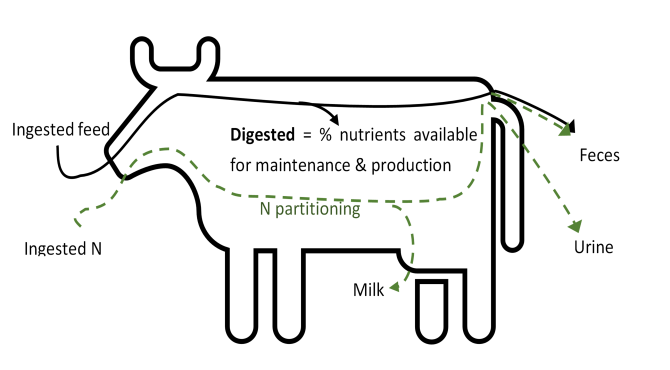
Are we turning cows into pigs? Let’s explore it together and volunteer for data collection!
WIAS Magazine - Spring edition 2023
Research Overview
Key words: digestibility, nitrogen partitioning, dairy cows, animal nutrition, animal breeding
Over the past decades, improvements in nutrition and genetic selection in dairy cows have resulted in increased milk yields. Meanwhile, other changes have been noticed, such as a decrease in the digestibility of fibre. Will cows be unable to digest grass in the future? In other words, are we turning cows into monogastric, like pigs? There is no need to exaggerate but it is essential to maintain or improve the key role cattle has in converting fibre-rich feed into high quality products for human consumption. To better understand what is happening and could happen in the future, PhD candidates Margreet Edens and Eugénie Guennoc explore the biological mechanisms and genetic factors underlying differences in feed digestibility between dairy cows.
Digestibility, a complex relation with sustainability related traits
Previously, genetic selection of dairy cows focused mainly on high milk or milk component production, but this has changed in recent decades with other traits being included or becoming more prominent in the breeding goals. Farmers are under pressure to improve feed resource efficiency and to reduce the environmental impact of dairy farming. Feed efficiency, expressed as the amount of energy-corrected milk produced per unit of dry matter intake, gained interest and the Dutch breeding company CRV recently included this trait in its breeding objective (CRV, n.a.). However, there is a lack of knowledge on the mechanisms behind the differences between cows in feed efficiency. Eugénie explains: “We still don’t know why some cows are more efficient than others. We hypothesise those differences may be explained by several physiological mechanisms, such as differences between cows in feed digestibility or feed intake patterns. Consequently, improving feed efficiency through breeding may have consequences on other factors, for instance digestibility.” Therefore, this project aims to better understand feed digestibility and the relation with these other traits, by combining knowledge from animal breeders and nutritionists and through a collaboration with CRV.
Why should we worry about cows’ digestibility?
Feed digestibility is defined as the difference between nutrients ingested with the feed and the nutrients excreted with the faeces (figure 1) (Mehtiö et al., 2016). Dairy cows play an important role in creating a sustainable food system through their ability to produce high quality food from fibrous feed, indigestible by humans. Therefore, a decreased in fibre digestibility, as already noticed (Potts et al., 2017), is undesirable. Margreet reflects: “considering the future role of cows in a circular food system – where land use and feed-food competition are critical issues – cows’ ability to convert human-inedible fibre-rich diets into high quality human-edible food should not be neglected.”
In addition to fibre digestibility, the project will also explore the digestibility of other nutrients, such as nitrogen (N). Nitrogen is excreted in milk, faeces and urine (figure 1); the latter two being well known for their environmental impact due to losses via ammonia, nitrate and nitrous oxide. Urinary N is much more susceptible to losses than faecal N (Dijkstra et al., 2013); hence, next to lowering total N excretion, a higher partitioning of N towards faeces compared to urine would be more desirable (Totty et al., 2013). However, limited knowledge is available about the relation between feed efficiency, N efficiency, N digestibility and in particular N partitioning between urine and faeces.

Figure 1: Digestibility scheme. Plain black line: feed digestibility. Dotted green line: nitrogen is partitioned between milk, urine and faeces.
Is it possible to improve cows’ digestibility?
Digestibility in cows has been estimated to be moderately heritable (Berry et al., 2007; Mehtiö et al., 2019), suggesting that improving digestibility is possible through genetics. However, these studies were based on a relatively small number of cows for estimating heritability (238 and 328, respectively). Moreover, the accuracy of the methods used in these studies to quantify digestibility can be debated; hence, a need for further studies. The current project will include data from 400 to 500 cows housed on 5 commercial farms in the Netherlands. These farms are equipped with feed bins (figure 2) to record feed intake and feed intake behaviour. Faecal samples are collected from individual cows to estimate their digestibility. In addition, urine samples are collected to analyse N efficiency and N partitioning.

Figure 2: The feed bins measure the weight of feed they contain. When a cow enters the feed bin, it is recognized by the sensor on its necklace. The visit length and weight of the feed removed from the feed bin is recorded throughout the day, providing information on the amount of feed eaten per cow per time unit.
How you can contribute to this study in 2023
Do you feel like having a break from working behind a computer? Then practical work might help you to get some more inspiration! We are looking for enthusiastic colleagues to help us collect faeces and urine samples from cows on several dairy farms. You are not a cow-person? No worry, we also need some people to help clean the material and to weigh and label the samples. This is a great opportunity to get to know colleagues from different chair groups and to visit a Dutch dairy farm. In addition, home-made cookies and meals will be prepared for you. Our next sampling will be during the first 2 weeks of June. We also plan some more after the summer break. If you are interested and would like more information about the tasks and schedule, please contact us: eugenie.guennoc@wur.nl or margreet.edens@wur.nl.
References
Berry, D. P., Horan, B., O’Donovan, M., Buckley, F., Kennedy, E., McEvoy, M., & Dillon, P. (2007). Genetics of Grass Dry Matter Intake, Energy Balance, and Digestibility in Grazing Irish Dairy Cows. Journal of Dairy Science, 90(10), 4835-4845. https://doi.org/10.3168/jds.2007-0116
CRV. (n.a.). CRV - Feed efficiency. Retrieved 02/05/2022 from https://crv4all.co.uk/en/service/feed-efficiency
Dijkstra, J., Oenema, O., van Groenigen, J. W., Spek, J. W., van Vuuren, A. M., & Bannink, A. (2013). Diet effects on urine composition of cattle and N2O emissions. animal, 7(s2), 292-302. https://doi.org/10.1017/S1751731113000578
Mehtiö, T., Mäntysaari, P., Kokkonen, T., Kajava, S., Prestløkken, E., Kidane, A., Wallén, S., Nyholm, L., Negussie, E., Mäntysaari, E. A., & Lidauer, M. H. (2019). Genetic parameters for cow-specific digestibility predicted by near infrared reflectance spectroscopy. Livestock Science, 226, 1-6. https://doi.org/10.1016/j.livsci.2019.05.017
Mehtiö, T., Rinne, M., Nyholm, L., Mäntysaari, P., Sairanen, A., Mäntysaari, E. A., Pitkänen, T., & Lidauer, M. H. (2016). Cow-specific diet digestibility predictions based on near-infrared reflectance spectroscopy scans of faecal samples. Journal of Animal Breeding and Genetics, 133(2), 115-125. https://doi.org/10.1111/jbg.12183
Potts, S. B., Shaughness, M., & Erdman, R. A. (2017). The decline in digestive efficiency of US dairy cows from 1970 to 2014. Journal of Dairy Science, 100(7), 5400-5410. https://doi.org/10.3168/jds.2017-12641
Totty, V. K., Greenwood, S. L., Bryant, R. H., & Edwards, G. R. (2013). Nitrogen partitioning and milk production of dairy cows grazing simple and diverse pastures. Journal of Dairy Science, 96(1), 141-149. https://doi.org/10.3168/jds.2012-5504


